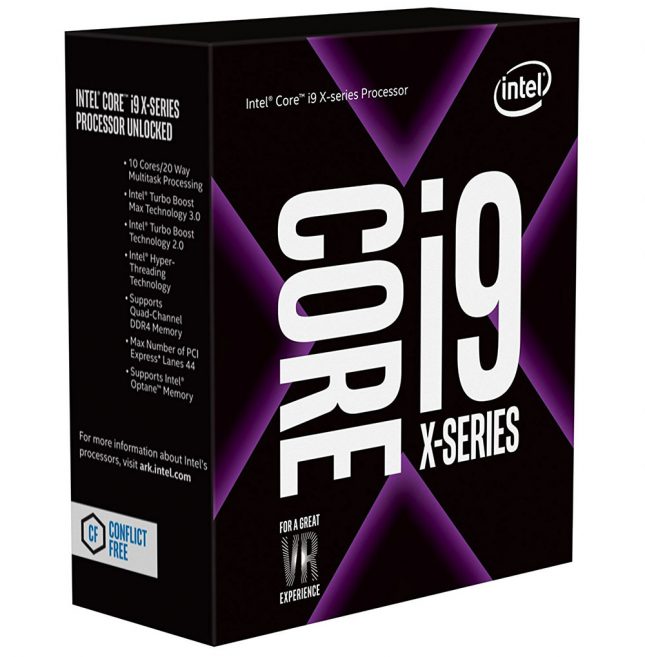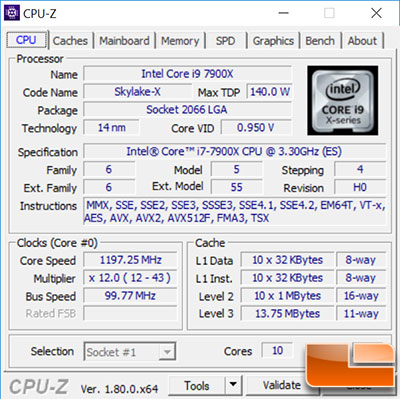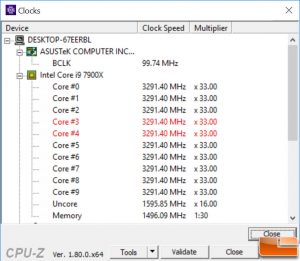Intel Core i9-7900X Processor Review
Intel Core i9-7900X – 10-Cores Refined
Today we’ll be taking a closer look at the Intel Core i9-7900X Skylake-X processor, which is Intel’s High-End Desktop Platform (HEDT) 10-core, 20-thread CPU (3.3 GHz base/4.5 GHz Boost/13.75MB Cache) that costs $1061.99 shipped over at Amazon. The Intel Core i9-7900X sounds like a powerhouse and it better be since it commands around $1,000 in the retail market. What is crazy though, is that price is over 40% less than the Intel Core i7-6950X processor cost. So, even at this rather high price point consumers are getting a better value than the previous processor generation!
A handful of 4- to 10-core Intel Core X-series processors have been available for purchase since June 26th, 2017 and it appears that they are doing well in the market despite the fact that Intel is only releasing the lower half of the product stack and has more versions with additional cores coming out later this year.
Intel Skylake-X and Kaby Lake-X Desktop CPU Lineup
| SKU Name | Cores/Threads | Base Clock | Turbo Boost 2.0 | Turbo Boost 3.0 | L3 Cache | TDP | PCIe Lanes | Price (USD) |
|---|---|---|---|---|---|---|---|---|
| Core i9-7900X | 10/20 | 3.3 GHz | 4.3 GHz | 4.5 GHz | 13.75 MB | 140W | 44 | $1,061.99 |
| Core i7-7820X | 8/16 | 3.6 GHz | 4.3 GHz | 4.5 GHz | 11 MB | 140W | 28 | $678.75 |
| Core i7-7800X | 6/12 | 3.5 GHz | 4.0 GHz | N/A | 8.25MB | 140W | 28 | $479.00 |
| Core i7-7740X | 4/8 | 4.3 GHz | 4.5 GHz | N/A | 8MB | 112W | 16 | $347.97 |
| Core i7-7640X | 4/4 | 4.0 GHz | 4.2 GHz | N/A | 6MB | 112W | 16 | $239.89 |
The Intel Core i9-7900X looks pretty good on paper as it has higher clock speeds and the latest Intel Turbo Boost 3.0 technology that is being seen for the very first time on Skylake-X processors. Intel Turbo Boost 3.0 technology allows the two-best performing cores on any given processor to have single- or dual-core speeds of up to 4.5GHz. Intel tests each processor at the factory to determine the best two cores and then sets those cores to boost higher when needed.
If you happen to have one of these processors you can open up a free utility called CPU-Z to find the best two cores as they are highlighted in red. On our Intel Core i9-7900X processor the two best cores just happen to be core #3 and core #4. Knowing this information might come in handy when overclocking on a per core basis versus leaving all cores the same and just cranking up the CPU multiplier.
The reduction of L3 cache and increase in the L2 cache might throw a few people off. The Intel engineering team thought it was time to re-balance the smart cache hierarchy on Skylake-X due to where they believe the software market is headed. Intel increased the L2 cache size from 256KB to 1MB per core while the L3 cache has gone from an inclusive to a non-inclusive format. This change will help some workloads while some might actually see a performance decrease. Intel Skylake-X desktop processors are the first to support the AVX-512 instruction set, so it is highly likely that these changes were brought to optimize for how those workloads are handled.
We’ll be taking a look at one of processors based on the Kaby Lake architecture in an upcoming article. Intel bringing out LGA2066 processors on both the Kaby Lake and Skylake architectures at the same time is an interesting move that has muddied up the product segmentation a little bit. The proble with the Kaby Lake based processors is they can’t take full advantage of the Intel X299 chipset. For example they don’t have support for quad-channel memory or have nearly as many PCIe lanes, so depending on the board you buy there will be ports, slots and headers that won’t work. The Intel Core i7-7740X and Core i5-7640X are basically the Core i7-7700K amd Core i5-7600K LG1151 desktop parts with the integrated graphics processor (IGP) removed and a higher TDP (91W originally bumped up to 112W now) on an LGA2066 part. This means they should overclock better, but the IPC performance is exactly the same. Buying a Kaby Lake-X processor along with an X299 board is going to be a more expensive investment, but it does give you an upgrade path to 18-core processors in the years to come. The Intel LGA2011 platform stuck around for many years and was solid, so it looks like Intel LGA2066 is going be as well.
Let’s move onto the benchmarks after looking at the test systems on the next page.




